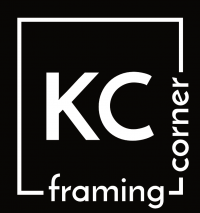Any time you hang a picture, organization and planning will help you achieve the look you want. Here are some things to consider:
Use Good Hooks. Never use just a nail. It is easy for the wire to slip off causing the picture to fall. We provide you with hangers appropriate for the size of your framed art work clipped to your wire. Avoid hanging heavy pictures from saw-tooth hangers as the top of the frame will bow over time.
57″ On Center. This rule is used by experts world wide. “On center” means that the middle of the artwork is always 57” from the floor. Mark a location on your wall 57″ from the floor and center you art work or gallery wall around that spot.
Location, Location. When hanging art, furniture often acts as an anchor for the art. Hang your art low enough to relate to the furniture. Tables, lamps, and chairs can be paired with art as a grouping as well. Having the art off-center can provide visual interest, especially when balanced by a lamp or other object.
Scale is Important in Design. Be sure your art is scaled appropriately for its location. For example, a large piece of art is well placed when used to balance a heavy fire place. Small pieces work well in groupings with lamps, vases, sculptures or other small pieces of art. Art that is too big tends to be better than art that is too small so if you are not sure if your scale is correct, ere on the side of large.
Visual Impact. We believe in loving your art! So hang up what you love! Place your best in the places that give you the most visual impact. If you’ve invested in a bright and vibrant piece of artwork, you’ll want it to be the star of the show. Place it where it will be the center point of the space. Traditional paintings don’t need to be displayed in a suitably furnished period interior and the perfect touch for an eclectic room can be to simply prop up your art against a bookcase or on the mantel.
Peculiar Hanging Situations. We will never let you leave the store without a hanging plan in place. For large pictures we may recommend a z-bar system that will hold heavy items and keep them closer to the wall. This options also works well with mirrors.
Hanging in Groups.
- Lay out your art. If you have a more irregular grouping of different styles and sizes try to find the “anchor” piece first and work around it. Try to think about balance and weight in your arrangement. Align the bottom edges of some frames with the top edges of others, align some left-hand edges, and center some frames over others. Positioning bigger pieces low and to the left keeps the display from looking top-heavy.
- Trace it out. Trace your frames on butcher paper and cut them out. Write a name for each piece on the cut-out so you can identify them.
- One perk of using paper cut-outs is they make nail placement easy. You can mark each paper with the spot where the picture framing hook should be placed. This point will not be where the nail is located but where the bottom of the picture hanging hook should be (the nail should be hammered in higher then this point).
- Tape your cut-outs to the wall where you would like your art to hang. Plan on moving them around a bit until you find the spacing you like.
- Remember that mark you made on your paper? Place the bottom of your hook at that point and hammer in the nail. DO NOT REMOVE THE PAPER CUT-OUT YET, hang up all your art first. If you need to make adjustments because you are not happy with how it turned out you can always move it and try again. The nails are very small and you will just have a pinhole to cover or patch.
- Once you are in love with your wall, take the art back down and remove the paper cut-outs. Before you re-hang your pictures check the nails to be sure none of them came loose. Then place them on the wall for good.
- Step back and enjoy your design.

